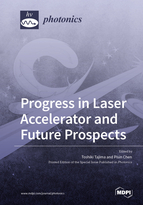Progress in Laser Accelerator and Future Prospects
A special issue of Photonics (ISSN 2304-6732).
Deadline for manuscript submissions: closed (15 May 2022) | Viewed by 36966
Special Issue Editors
2. International Center for Zetta- Exawatt Science and Technology (IZEST), Ecole Polytechnique, F-91128 Paris, France
Interests: plasma physics; accelerators; lasers; plasma astrophysics
2. Department of Physics, National Taiwan University, Taipei 10617, Taiwan
Interests: black hole physics; cosmology; particle astrophysics; beam physics; plasma physics
Special Issue Information
Dear Colleagues,
Laser wakefield acceleration (LWFA) drives the future of accelerators. Wakefields in a plasma by laser may be 4 orders magnitude higher over fields in RF-based accelerators. These are coherent collective fields, in contrast to individual particle forces. The advances in laser and particle beam technologies drive us into higher frequencies (such as X-rays), which also open up the possibility of even more compact laser accelerators based on nanomaterials or other solid- state media. When taking different advantages of LWFA and the particle-beam driven PWFA, a hybrid plasma accelerator approach can provide additional potential applications.
We may contemplate future high energy accelerators based on these prospects. Their advancements can also usher in HD (high-density) LWFA, which may be adapted to the tip of fiber lasers, for example, acting as an endoscopic cancer therapy device. Mother Nature also sends us her signal that cosmic events such as active galactic nuclei (AGN) and neutron star coalescence are accompanied by cosmic wakefields. Additional exciting prospects of applications are not limited to future high energy accelerators, but also to quantum gravity, such as the investigation of the black hole Hawking effect, and to non-thermal nuclear fusion.
This Special Issue aims at presenting an overview of cutting-edge research vision, results, and their applications. We welcome broad, visionary contributions of short research reports as well as a collection of reviews of accomplishments. We are excited to invite researchers to submit their contributions to this Special Issue. Topics include but are not limited to:
- Laser accelerators;
- Collective wakefield dynamics, its control, experimental realizations, and measurements;
- LWFA for a future high-energy accelerator;
- Hybrid LWFA-PWFA;
- High-density LWFA;
- Laser ion acceleration;
- Medical and other applications of LWFA;
- LWFA and X-rays;
- Cosmic wakefields and observational signatures;
- Laser wakefield induced analog black holes;
- Wakefields for fusion and fission
Prof. Dr. Toshiki Tajima
Prof. Dr. Pisin Chen
Guest Editors
Manuscript Submission Information
Manuscripts should be submitted online at www.mdpi.com by registering and logging in to this website. Once you are registered, click here to go to the submission form. Manuscripts can be submitted until the deadline. All submissions that pass pre-check are peer-reviewed. Accepted papers will be published continuously in the journal (as soon as accepted) and will be listed together on the special issue website. Research articles, review articles as well as short communications are invited. For planned papers, a title and short abstract (about 100 words) can be sent to the Editorial Office for announcement on this website.
Submitted manuscripts should not have been published previously, nor be under consideration for publication elsewhere (except conference proceedings papers). All manuscripts are thoroughly refereed through a single-blind peer-review process. A guide for authors and other relevant information for submission of manuscripts is available on the Instructions for Authors page. Photonics is an international peer-reviewed open access monthly journal published by MDPI.
Please visit the Instructions for Authors page before submitting a manuscript. The Article Processing Charge (APC) for publication in this open access journal is 2400 CHF (Swiss Francs). Submitted papers should be well formatted and use good English. Authors may use MDPI's English editing service prior to publication or during author revisions.
Keywords
- Laser accelerators
- Collective wakefield dynamics, its control, experimental realizations, and measurements
- LWFA for a future high-energy accelerator
- Hybrid LWFA-PWFA
- High-density LWFA
- Laser ion acceleration
- Medical and other applications of LWFA
- LWFA and X-rays
- Cosmic wakefields and observational signatures
- Laser wakefield induced analog black holes
- Wakefields for fusion and fission energies







